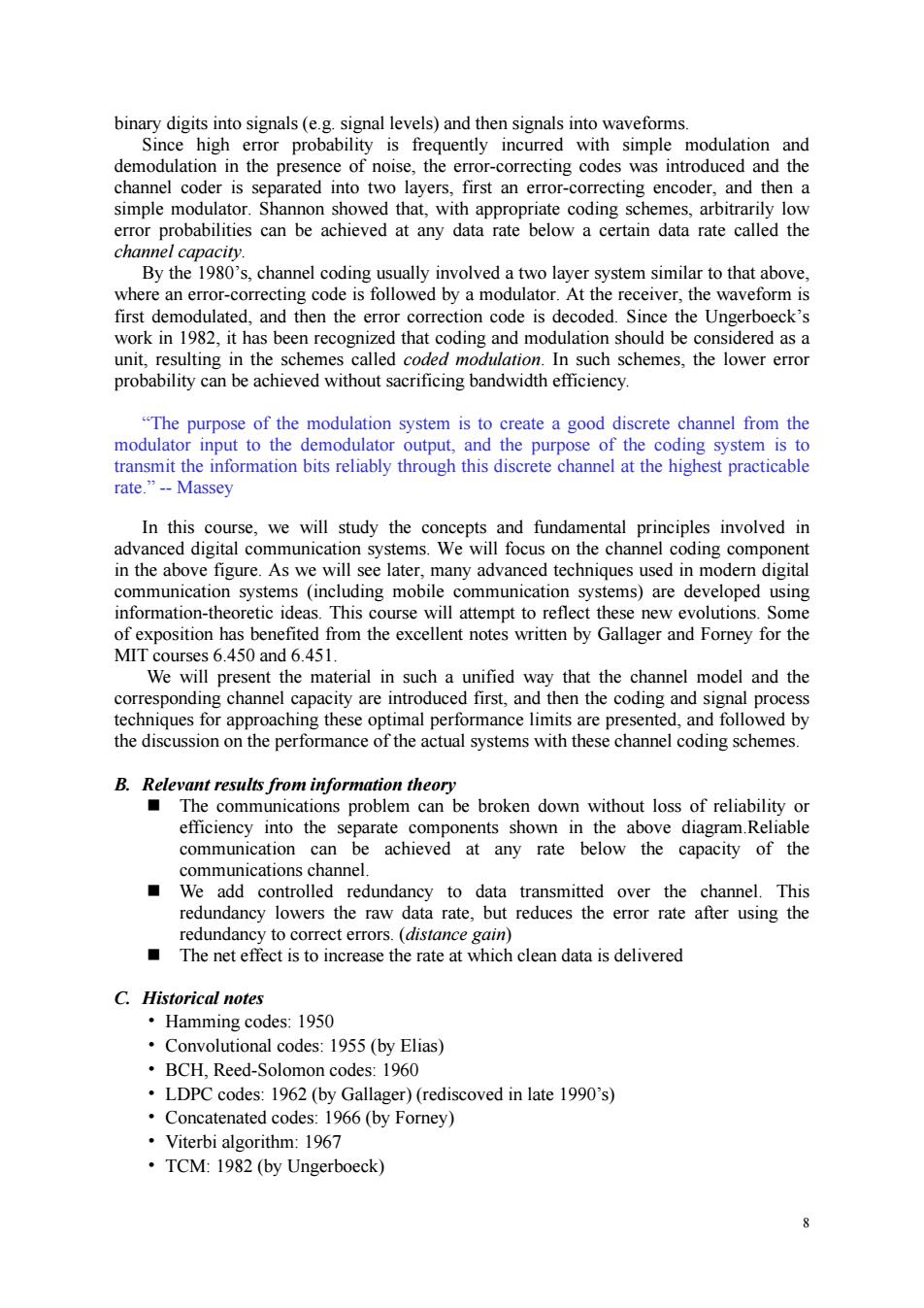正在加载图片...

binary digits into signals(e.g.signal levels)and then signals into waveforms. Since high error probability is frequently incurred with simple modulation and demodulation in the presence of noise,the error-correcting codes was introduced and the channel coder is separated into two layers,first an error-correcting encoder,and then a simple modu lator.Shannon showed that,with appropriate coding schemes,arbitrarily low error probabilities can be achieved at any data rate below a certain data rate called the cha s,channel codin ally involved a ystem similar to that above t then the err a m rrect ode the 198 e Ungerbo alled In s The nurnose of the modulation svstem is to create a good discrete channel from the modulator input to the demodulator output and the purnose of the coding system is to transmit the information bits reliably through this discrete channel at the highest practicable rate."-Massev In this we the d fundamental A、unic ad d te ed in are information-theoretic ideas.This course will attempt to reflect these new evolutions Som of exposition has benefited from the excellent notes written by Gallager and Forney for the MIT courses 6.450 and 6.451. We will present the material in such a unified way that the channel model and the corresponding channel capacity are introduced first,and then the coding and signal process techniques for approaching these optimal performance limits are presented,and followed by the discussion on the performance of the actual systems with these channel coding schemes commu cat ons problem can be brok n dow without loss of reliab the shown in a communi can any rate elow mitted over the channel.This redundancy lowers the raw data ror rate after using the edundand to correct errors.(distance The net effect is to increase the rate at which clean data is delivered C.Historical notes ·Hamming codes"1g50 Convolutional codes:1955 (by Elias) ·BCH,Reed-Solomo ncodes:1960 ·LDPC codes: 1962(by Gallager)(rediscoved in late 1990's) ·Concatenated codes.l966(by Forney)】 Viterbi algorithm:1967 TCM:1982(by Ungerboeck) 88 binary digits into signals (e.g. signal levels) and then signals into waveforms. Since high error probability is frequently incurred with simple modulation and demodulation in the presence of noise, the error-correcting codes was introduced and the channel coder is separated into two layers, first an error-correcting encoder, and then a simple modulator. Shannon showed that, with appropriate coding schemes, arbitrarily low error probabilities can be achieved at any data rate below a certain data rate called the channel capacity. By the 1980’s, channel coding usually involved a two layer system similar to that above, where an error-correcting code is followed by a modulator. At the receiver, the waveform is first demodulated, and then the error correction code is decoded. Since the Ungerboeck’s work in 1982, it has been recognized that coding and modulation should be considered as a unit, resulting in the schemes called coded modulation. In such schemes, the lower error probability can be achieved without sacrificing bandwidth efficiency. “The purpose of the modulation system is to create a good discrete channel from the modulator input to the demodulator output, and the purpose of the coding system is to transmit the information bits reliably through this discrete channel at the highest practicable rate.” - Massey In this course, we will study the concepts and fundamental principles involved in advanced digital communication systems. We will focus on the channel coding component in the above figure. As we will see later, many advanced techniques used in modern digital communication systems (including mobile communication systems) are developed using information-theoretic ideas. This course will attempt to reflect these new evolutions. Some of exposition has benefited from the excellent notes written by Gallager and Forney for the MIT courses 6.450 and 6.451. We will present the material in such a unified way that the channel model and the corresponding channel capacity are introduced first, and then the coding and signal process techniques for approaching these optimal performance limits are presented, and followed by the discussion on the performance of the actual systems with these channel coding schemes. B. Relevant results from information theory The communications problem can be broken down without loss of reliability or efficiency into the separate components shown in the above diagram.Reliable communication can be achieved at any rate below the capacity of the communications channel. We add controlled redundancy to data transmitted over the channel. This redundancy lowers the raw data rate, but reduces the error rate after using the redundancy to correct errors. (distance gain) The net effect is to increase the rate at which clean data is delivered C. Historical notes • Hamming codes: 1950 • Convolutional codes: 1955 (by Elias) • BCH, Reed-Solomon codes: 1960 • LDPC codes: 1962 (by Gallager) (rediscoved in late 1990’s) • Concatenated codes: 1966 (by Forney) • Viterbi algorithm: 1967 • TCM: 1982 (by Ungerboeck)